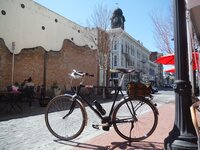"Riding without the need to pedal at all" means you need a throttle. Class 2 ebikes, strictly speaking, are the ones with throttles. You want to either look for a bike that says it has "a throttle" or designates itself as a "class 2 ebike" What
@Dave Rocks is saying can also come into play: That is, a manufacturer will include a throttle on a Class 3 bike and that throttle is only functional up to the Class 2 limit. I won't get into the whys and wherefores of this as that is not what you asked for.
Setting PAS to a particular speed limit - and in fact your entire question - is a bit of a misnomer. NO ebikes do (or should) have a speed limit. What they have is an 'assist limit'. That means they assist up to a certain speed and then they do not assist any more, leaving further speed increase up to you and your legs/muscles/lungs. Thats particularly meaningful for PAS as when you are pedaling you are working the bike with your muscles to at least some degree. Most simply, you can use the Class 1, 2 and 3 ebike speeds to figure out what the assist limits for your chosen bike are.
But the top speed is up to you. This makes a little more sense if you consider my own example: I build my own bikes. As a part of that, while I may have a motor that peaks at about 28 mph, I geared my bike in such a way that if I can maintain 70-75 rpm cadence, I am traveling at up to 34 mph. Most factory bikes aren't geared like this, but its not uncommon for stronger riders to change out the chainrings or rear cluster so they can pedal hard at higher speeds than the manufacturer intended. It lets them/me ride fast but also get a strong workout.
